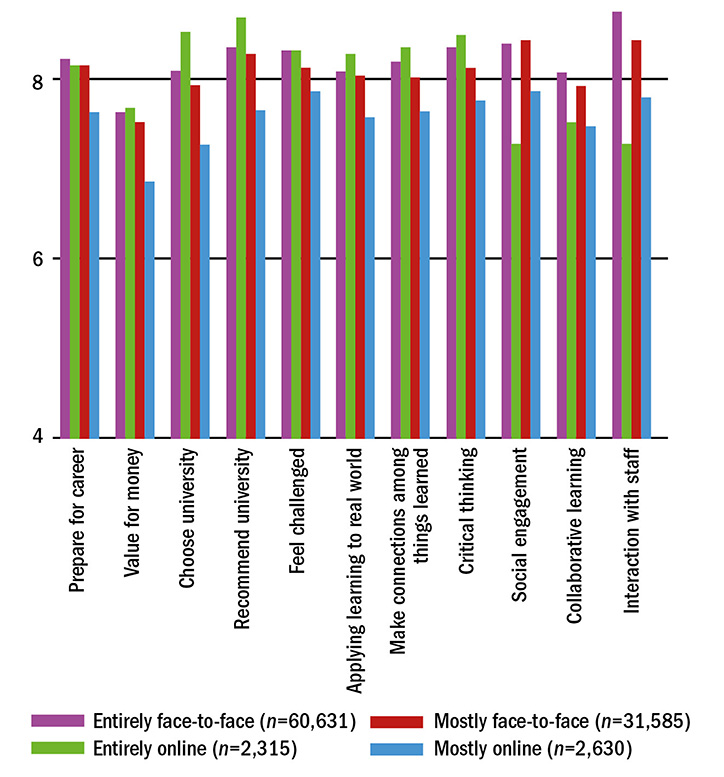US students on blended learning courses are generally less engaged with the teaching at their institution than their counterparts taking purely online or purely face-to-face degrees, according to a Times Higher Education survey that may question the notion that blended learning could result in a “great revolution in university teaching”.
Students undertaking courses that combine both online delivery with face-to-face interaction were less likely to say that they felt prepared for a career, were challenged by the teaching, were able to apply their learning to the real world, could make connections among things they learned, or were able to learn critical thinking skills.
They also said they thought their degree was worse value for money and they would be less likely to recommend their university to a friend or choose their college again.
The research was based on a survey of 100,000 students at US universities, which asked participants to identify whether they were taught entirely face-to-face while possibly supported by digital tools; primarily face-to-face with substantial online activities; entirely through an online platform while possibly with face-to-face faculty check-ins; or mostly through a digital platform with face-to-face faculty interactions.
On all of the above questions, students on mostly online courses said they were less engaged than those on primarily face-to-face ones, but both groups were less satisfied than their colleagues on entirely online and entirely face-to-face courses.
Students on entirely online courses were the most satisfied on nearly all the above measures, with the exception of whether they felt challenged – where students gave the same average score as those on entirely face-to-face courses – and feeling prepared for a career, where entirely face-to-face students scored highest.
However, when it comes to interacting with staff, opportunities for collaborative learning and social engagement, students on entirely or mostly face-to-face courses were more satisfied than those on entirely or mostly online courses.
Student engagement scores by course delivery method
For each survey question, students were asked to rate their university on a scale of one to 10, where zero represented no support and 10 represented being fully supported.
When asked whether they could make connections among things learned, for example, students on mostly online and mostly face-to-face courses gave an average score of 7.7 and 8.04 respectively, while students on entirely online and entirely face-to-face courses gave an average of 8.42 and 8.25 (see graphs).
Students at both public and private not-for-profit institutions felt less engaged with blended learning courses, but at private universities students on entirely face-to-face courses tended to be most satisfied, while at public universities students on entirely online courses generally gave the highest average score.
The findings come despite many university leaders seeing blended learning as key to the future of higher education.
In September, Warren Bebbington, vice-chancellor of the University of Adelaide, told the THE World Academic Summit that he predicted a “great revolution in university teaching” along the lines of the approach taken at his institution, where the broadcasting of lectures online freed up academics’ time to focus on small group discussions and laboratory-based teaching.
Meanwhile, earlier this year, John Hennessy, former president of Stanford University, told THE that the flipped classroom model – in which students watch video lectures at home and class time is devoted to discussions and interactive problem-solving – could be the future of higher education, but warned that much work still needs to be done to make the model work for all students.
When asked in the free comment section of the survey how their institution could improve, several students on blended learning courses cited the quality of the teaching, asking for “better professors” and academics with “more experience of teaching”.
Others wanted more interaction with staff, citing “the amount my professors can help me” and “teachers having better office hours” as key areas of improvement.
Mike Sharples, chair in educational technology at the UK’s Open University, said the survey results do not show that “blended learning is a failure”, but either that universities do not yet know “how to blend properly” or that “there is a difference between what students say they like and what they do better at”.
He cited recent research from the Open University, which found that students are more satisfied with courses that are “heavy on” assimilative learning and interactive elements but are better at courses with a stronger element of online discussion.
He added that a meta-analysis and review of online learning studies carried out by non-profit research organisation SRI International for the US Department of Education in 2010 found that students on blended learning courses achieved better outcomes.
“It’s still very early days and universities are still experimenting with how blended learning works,” he said. “They may just not have got blended learning right yet or students may not feel properly supported.”
The THE US Student Survey formed a major part of the methodology of the inaugural Wall Street Journal/Times Higher Education College Ranking, which ranked more than 1,000 US universities and colleges and was published in September. The survey was conducted online; respondents were recruited by research firm, Streetbees.
Of the students surveyed, 60,631 were taught entirely face-to-face, 31,585 were taught primarily face-to-face, 2,630 were taught mostly through a digital platform and 2,315 were taught entirely through an online platform.
Editor’s note: 16 June 2017
The information on this page was correct at the time of publication. Since then, Times Higher Education has reissued the US College Rankings. For the most up-to-date 2017 US College Rankings results, always use the overall league table. Click here for more information.
POSTSCRIPT:
Print headline: It’s not all in the blend for engagement
Register to continue
Why register?
- Registration is free and only takes a moment
- Once registered, you can read 3 articles a month
- Sign up for our newsletter
Subscribe
Or subscribe for unlimited access to:
- Unlimited access to news, views, insights & reviews
- Digital editions
- Digital access to THE’s university and college rankings analysis
Already registered or a current subscriber? Login









